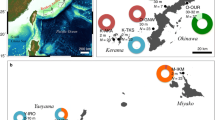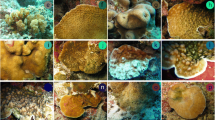Abstract
A total of 43 colonies of the scleractinian coral Pocillopora damicornis from lagoonal and reef slope sites in the western Indian Ocean (WIO) region were genetically characterised at one nuclear and two mitochondrial sequence markers and six microsatellite loci. Both mitochondrial and microsatellite data support the existence of two reciprocally monophyletic clusters (F- and NF-types) and provide evidence of the existence of two cryptic species of P. damicornis on reefs in WIO region and put current morphological delineation and geographical boundaries of P. damicornis and Pocillopora molokensis into question. The results add to ongoing studies on the phylogeny and phylogeography within the genus Pocillopora, which all point towards a range of unresolved morphological and molecular species boundaries. Nuclear phylogenies derived from the present and previously published sequences show evidence for incomplete lineage sorting and/or introgressive hybridisation between Pocillopora morphospecies. However, the two WIO types largely remain in separate clusters, further supporting the theory that these represent two different species.





Similar content being viewed by others
References
Adjeroud M, Tsuchiya M (1999) Genetic variation and clonal structure in the scleractinian coral Pocillopora damicornis in the Ryukyu Archipelago, southern Japan. Mar Biol 134:753–760
Ayre DJ, Miller KJ (2004) Where do clonal coral larvae go? Adult genotypic diversity conflicts with reproductive effort in the brooding coral Pocillopora damicornis. Mar Ecol Prog Ser 277:95–105
Ayre DJ, Hughes TP, Standish RJ (1997) Genetic differentiation, reproductive mode, and gene flow in the brooding coral Pocillopora damicornis along the Great Barrier Reef, Australia. Mar Ecol Prog Ser 159:175–187
Belkir K, Borosa P, Goudete J, Chiki L, Bonhomme F (1996) Genetix, Logiciel sous Windows™ pour la genetique des populations. Laboratoire Genome, Populations, Interaction. CNRS IMR 5000. Universite Montpellier II, Montpellier
Benzie JAH, Haskell A, Lehman H (1995) Variation in the genetic composition of coral (Pocillopora damicornis and Acropora palifera) populations from different reef habitats. Mar Biol 121:731–739
Calendini F, Martin J-F (2005) PaupUp: a free graphical frontend for Paup Dos software
Caputi L, Andreakis N, Mastrototaro F, Cirino P, Vassillo M, Sordino P (2007) Cryptic speciation in a model invertebrate chordate. Proc Natl Acad Sci USA 104:9364–9369
Cockerham CC, Weir BS (1984) Covariances of relatives stemming from a population undergoing mixed self and random mating. Biometrics 40:157–164
Combosch DJ, Guzman HM, Schuhmacher H, Vollmer SV (2008) Interspecific hybridization and restricted trans-Pacific gene flow in the Tropical Eastern Pacific Pocillopora. Mol Ecol 17:1304–1312
Flot J, Tillier S (2006) Molecular phylogeny and systematics of the scleractinian coral genus Pocillopora in Hawaii 10th International Coral Reef Symposium Okinawa, pp 24–29
Flot JF, Tillier S (2007) The mitochondrial genome of Pocillopora (Cnidaria : Scleractinia) contains two variable regions: the putative D-loop and a novel ORF of unknown function. Gene 401:80–87
Flot JF, Licuanan WY, Nakano Y, Payri C, Cruaud C, Tillier S (2008a) Mitochondrial sequences of Seriatopora corals show little agreement with morphology and reveal the duplication of a tRNA gene near the control region. Coral Reefs 27:789–794
Flot JF, Magalon H, Cruaud C, Couloux A, Tillier S (2008b) Patterns of genetic structure among Hawaiian corals of the genus Pocillopora yield clusters of individuals that are compatible with morphology. Comptes Rendus Biologies 331:239–247
Forsman Z, Barshis D, Hunter C, Toonen R (2009) Shape-shifting corals: molecular markers show morphology is evolutionarily plastic in Porites. BMC Evol Biol 9:45
Fukami H, Budd AF, Levitan DR, Jara J, Kersanach R, Knowlton N (2004a) Geographic differences in species boundaries among members of the Montastrea annularis complex based on molecular and morphological markers. Evolution 58:234–337
Fukami H, Budd AF, Paulay G, Sole-Cava A, Chen CLA, Iwao K, Knowlton N (2004b) Conventional taxonomy obscures deep divergence between Pacific and Atlantic corals. Nature 427:832–835
Harriott VJ (1983) Reproductive ecology of four scleractinian species at Lizard Island, Great Barrier Reef. Coral Reefs 2:9–18
Jokiel P (1984) Long distance dispersal of reef corals by rafting. Coral Reefs 3:113–116
Jokiel P (1989) Rafting of reef corals and other organisms at Kwajalein Atoll. Mar Biol 101:483–493
Knowlton N (1993) Sibling species in the sea. Annu Rev Ecol Syst 24:189–216
Knowlton N (2000) Molecular genetic analyses of species boundaries in the sea. Hydrobiologia 420:73–90
Kumar S, Tamura K, Nei M (2004) MEGA 3: integrated software for molecular evolutionary genetics analysis and sequence alignment. Breif Bioinform 5:150–163
Laval LG, Schneider S (2005) Arlequin ver. 3.0: an integrated software package for population genetics data analysis. Evol Bioinform Online 1:47–50
Lopez JV, Kersanach r, Rehner SA, Knowlton N (1999) Molecular determination of species boundaries in corals: genetic analysis of the Montastrea annularis complex using amplified fragment length polymorphisms and a microsatellite marker. Biol Bull 196:80–93
Magalon H, Samadi S, Richard M, Adjeroud M, Veuille M (2004) Development of coral and zooxanthella-specific microsatellites in three species of Pocillopora (Cnidaria, Scleractinia) from French Polynesia. Mol Ecol Notes 4:206–208
Mangubhai S, Harrison PL, Obura DO (2007a) Patterns of coral larval settlement on lagoon reefs in the Mombasa Marine National Park and Reserve, Kenya. Mar Ecol Prog Ser 348:149–159
Mangubhai S, Souter P, Grahn M (2007b) Phenotypic variation in the coral Platygyra daedalea in Kenya: morphometry and genetics. Mar Ecol Prog Ser 345:105–115
Marquez LM, Miller DJ, MacKenzie JB, van Oppen MJH (2003) Pseudogenes contribute to the extreme diversity of nuclear ribosomal DNA in the hard coral Acropora. Mol Biol Evol 20:1077–1086
Miller KJ, Ayre DJ (2004) The role of sexual and asexual reproduction in structuring high latitude populations of the reef coral Pocillopora damicornis. Heredity 92:557–568
Miller K, Babcock R (1997) Conflicting morphological and reproductive species boundaries in the coral genus Platygyra. Biol Bull 192:98–110
Miller KJ, Benzie JAH (1997) No clear genetic distinction between morphological species within the coral genus Platygyra. Bull Mar Sci 61:907–917
Nunes F, Fukami H, Vollmer SV, Norris RD, Knowlton N (2008) Re-evaluation of the systematics of the endemic corals of Brazil by molecular data. Coral Reefs 27:423–432
Park SDE (2001) Trypanotolerance in West African cattle and the population genetic effects of selection
Posada D, Crandall KA (1998) MODELTEST: testing the model of DNA substitution. Bioinformatics 14:817–818
Richmond RH (1987) Energetic relationships and biogeographical differences among fecundity, growth and reproduction in the reef coral Pocillopora damicornis. Bull Mar Sci 41:594–604
Richmond RH, Jokiel PL (1984) Lunar periodicity in larva released in the reef coral Pocillopora damicornis at Enewetak and Hawaii. Bull Mar Sci 34:280–287
Rozas J, Sanchez-DelBarrio JC, Messeguer X, Rozas R (2003) DnaSP, DNA polymorphism analyses by the coalescent and other methods. Bioinformatics 19:2496–2497
Sáez AG, Probert I, Geisen M, Quinn P, Young JR, Medlin LK (2003) Pseudo-cryptic speciation in coccolithophores. Proc Natl Acad Sci USA 100:7163–7168
Schleyer MH, Kruger A, Benayahu Y (1997) Reproductive strategies of South African corals. In: den Hartog JC, van Ofwegen LP, van der Spoel S (eds) 6th International conference of coelenterate biology, Leiden, The Netherlands, pp 429–435
She J, Autem M, Kotoulas G, Pasteru N, Bonhomme F (1987) Multivariate analysis of genetic exchange between Solea aegyptiaca and Sloea senelagensis (Teleosts, Soleidae). Biol J Linn Soc 32:357–371
Sherman CDH, Ayre DJ, Miller KJ (2006) Asexual reproduction does not produce clonal populations of the brooding coral Pocillopora damicornis on the Great Barrier Reef, Australia. Coral Reefs 25:7–18
Souter P, Henriksson O, Olsson N, Grahn M (2009) Patterns of genetic structuring in the coral Pocillopora damicornis on reefs in East Africa. BMC Ecol 9:19
Starger CJ, Yeoh SSR, Dai CF, Baker AC, Desalle R (2008) Ten polymorphic STR loci in the cosmopolitan reef coral, Pocillopora damicornis. Mol Ecol Res 8:619–621
Stobart B (2000) A taxonomic reappraisal of Montipora digitata based on genetic and morphometric evidence. Zool Stud 39:179–190
Stoddart JA (1983) Asexual production of planulae in the coral Pocillopora damicornis. Mar Biol 76:279–284
Stoddart JA (1984a) Genetic differentiation amongst populations of the coral Pocillopora damicornis off Southwestern Australia. Coral Reefs 3:149–156
Stoddart JA (1984b) Genetical structure within populations of the coral Pocillopora damicornis. Mar Biol 81:19–30
Stoddart JA (1986) Biochemical genetics of Pocillopora damicornis in Kaneohe Bay, Oahu, Hawaii. In: Joikel PL, Richmond RH, Rogers RA (eds) Coral reef population biology. Hawaii Institute of Marine Biology, Oahu, pp 133–148
Stoddart JA, Black R (1985) Cycles of gametogenesis and planulation in the coral Pocillopora damicornis. Mar Ecol Prog Ser 23:153–164
Swofford DL (2000) PAUP*. Phylogenetic analysis using parsimony (*and other methods). Sinauer Associates, Sunderland
Todd PA (2008) Morphological plasticity in scleractinian corals. Biol Rev 83:315–337
van Oppen MJH, Willis BL, van Vugt H, Miller DJ (2000) Examination of species boundaries in the Acropora cervicornis group (Scleractinia, Cnidaria) using nuclear DNA sequence analyses. Mol Ecol 9:1363–1373
van Oppen MJH, McDonald BJ, Willis B, Miller DJ (2001) The evolutionary history of the coral genus Acropora (Scleractinia, Cnidaria) based on a mitochondrial and a nuclear marker: reticulation, incomplete lineage sorting, or morphological convergence? Mol Biol Evol 18:1315–1329
van Oppen MJH, Willis BL, Van Rheede T, Miller DJ (2002) Spawning times, reproductive compatibilities and genetic structuring in the Acropora aspera group: evidence for natural hybridization and semi-permeable species boundaries in corals. Mol Ecol 11:1363–1376
Veron J (2000) Corals of the world. Australian Institute of Marine Science, Townsville
Vollmer S, Palumbi SR (2002) Hybridization and the evolution of reef coral diversity. Science 296:2023–2025
Vollmer S, Palumbi S (2004) Testing the utility of internally transcribed spacer sequences in coral phylogenetics. Mol Ecol 13:2763–2772
Ward S (1992) Evidence for broadcast spawning as well as brooding in the scleractinian coral Pocillopora damicornis. Mar Biol 112:641–646
Whitaker K (2006) Genetic evidence for mixed modes of reproduction in the coral Pocillopora damicornis and its effect on population structure. Mar Ecol Prog Ser 306:115–124
Zvuloni A, Mokady O, Al-Zibdah M, Bernardi G, Gaines SD, Abelson A (2008) Local scale genetic structure in coral populations: a signature of selection. Mar Pollut Bull 56:430–438
Acknowledgments
This study was funded by grants from the Swedish Development Cooperation Agency, the western Indian Ocean Marine Science Association and in-kind contributions from Sodertorn University College and the Australian Institute of Marine Science. Collections were made by the author, O. Henriksson, N. Olssson, S. Said, R. Moothien-Pillay and S. Visram. A proportion of the DNA extractions was made by staff and students at CORDIO-EA. The author would especially like to acknowledge N. Andreakis for discussions and help regarding constructing phylogenies, interpretation and presentation of the data, L. Tynan for language editing and T. Simmonds for producing maps and figures.
Author information
Authors and Affiliations
Corresponding author
Additional information
Communicated by T. Reusch.
Electronic supplementary material
Below is the link to the electronic supplementary material.
Rights and permissions
About this article
Cite this article
Souter, P. Hidden genetic diversity in a key model species of coral. Mar Biol 157, 875–885 (2010). https://doi.org/10.1007/s00227-009-1370-3
Received:
Accepted:
Published:
Issue Date:
DOI: https://doi.org/10.1007/s00227-009-1370-3




